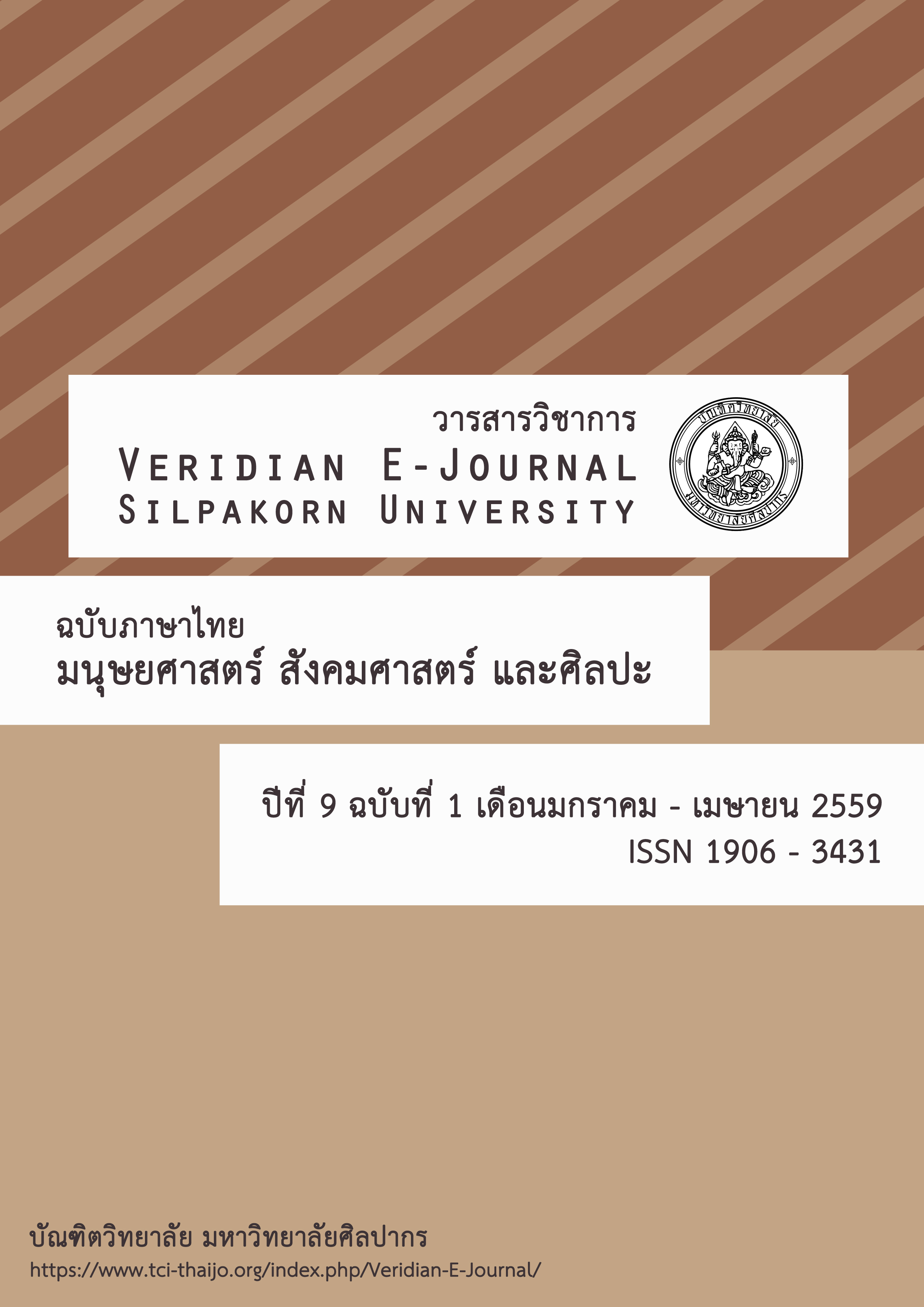การพัฒนารูปแบบการจัดการเรียนรู้เพื่อเสริมสร้างการคิดสร้างสรรค์อย่างมีวิจารณญาณ สำหรับนิสิตสาขาวิชาการออกแบบทัศนศิลป์
Main Article Content
บทคัดย่อ
บทคัดย่อ
การวิจัยนี้มีความมุ่งหมายเพื่อ 1) เพื่อพัฒนารูปแบบการจัดการเรียนรู้ที่เสริมสร้างการคิดสร้างสรรค์อย่างมีวิจารณญาณสำหรับนิสิตสาขาวิชาการออกแบบทัศนศิลป์ 2) เพื่อศึกษาประสิทธิผลของรูปแบบการจัดการเรียนรู้ที่เสริมสร้างการคิดสร้างสรรค์อย่างมีวิจารณญาณสำหรับนิสิตสาขาวิชาการออกแบบทัศนศิลป์ กลุ่มตัวอย่างในการวิจัย คือ นิสิตที่กำลังศึกษาอยู่ในสาขาวิชาการออกแบบทัศนศิลป์ ระดับปริญญาตรี คณะศิลปกรรมศาสตร์ มหาวิทยาลัยมหาวิทยาลัยศรีนครินทรวิโรฒ จำนวน 23 คน เครื่องมือที่ใช้ในการวิจัยครั้งนี้ แบ่งเป็น 2 ประเภท ได้แก่ 1) เครื่องมือที่ใช้ในการวิเคราะห์ข้อมูลพื้นฐาน ได้แก่ 1.1 แบบบันทึกเอกสารงานวิจัยที่เกี่ยวข้อง 1.2 แบบสัมภาษณ์กึ่งโครงสร้าง 2) เครื่องมือที่ใช้ในการเก็บรวบรวมข้อมูล ได้แก่ 2.1 แบบทดสอบวัดการคิดสร้างสรรค์อย่างมีวิจารณญาณ 2.2 แบบประเมินพฤติกรรมการเป็นนักคิดสร้างสรรค์อย่างมีวิจารณญาณ 2.3 แฟ้มสะสมผลงาน ผลการวิจัยพบว่า รูปแบบการจัดการเรียนรู้ที่เสริมสร้างการคิดสร้างสรรค์อย่างมีวิจารณญาณสำหรับนิสิตสาขาวิชาการออกแบบทัศนศิลป์ ประกอบด้วย 1) หลักการ 2) วัตถุประสงค์ 3) แผนการจัดการเรียนรู้ 4) ขั้นตอนของรูปแบบการจัดการเรียนรู้ ( ขั้นที่ 1. สร้างแรงบันดาลใจ ขั้นที่ 2 ปฏิบัติการออกแบบ ประกอบด้วย 2.1 ระดมสมองเพื่อค้นหาปัญหา 2.2 ทำความกระจ่างและสรุปปัญหาการออกแบบ 2.3 สร้างแนวความคิดหลัก 2.4 ออกแบบและพัฒนาแบบ 2.5 ประเมินผลงานออกแบบและพัฒนาต่อยอด) ขั้นที่ 3 นำเสนอผลงานและแลกเปลี่ยนเรียนรู้ ขั้นที่ 4 ประเมินผล) และ 5)การประเมินผลตามสภาพจริง ผลการประเมินประสิทธิผลรูปแบบการจัดการเรียนรู้ พบว่า 1 คะแนนการคิดสร้างสรรค์อย่างมีวิจารณญาณของผู้เรียนก่อนเรียนและหลังเรียนมีความแตกต่างกันอย่างมีนัยสำคัญทางสถิติที่ระดับ .05 โดยคะแนนการคิดสร้างสรรค์อย่างมีวิจารณญาณหลังเรียนสูงกว่าก่อนเรียน และคะแนนการคิดสร้างสรรค์อย่างมีวิจารณญาณของผู้เรียนแต่ละช่วง (3 ช่วง) เพิ่มขึ้นอย่างมีนัยสำคัญทางสถิติที่ระดับ.05 2) ผลการประเมินพฤติกรรมการเป็นนักคิดสร้างสรรค์อย่างมีวิจารณญาณโดยผู้วิจัย และนิสิต พบว่า ผู้เรียนมีพฤติกรรมการเป็นนักคิดสร้างสรรค์
อย่างมีวิจารณญาณในระดับมากที่สุด และคะแนนพฤติกรรมการเป็นนักคิดสร้างสรรค์อย่างมีวิจารณญาณในแต่ละช่วง (3 ช่วง) มีแนวโน้มสูงขึ้น 3) ผลการประเมินพัฒนาการคิดสร้างสรรค์อย่างมีวิจารณญาณของผู้เรียนจากแบบประเมินแฟ้มสะสมผลงานอยู่ในระดับดีมาก ผู้เรียนมีพัฒนาการและมีแนวโน้มของพัฒนาการด้านคิดสร้างสรรค์อย่างมีวิจารณญาณสูงขึ้นในแต่ละช่วง (3 ช่วง)
คำสำคัญ : การจัดการเรียนรู้ , การคิดสร้างสรรค์อย่างมีวิจารณญาณ , นิสิตสาขาวิชาการออกแบบทัศนศิลป์
Abstract
The objectives of this research are 1) to develop a learning management model to enhance critical and creative thinking for visual design students, 2) to study the effectiveness of a learning management model to enhance critical and creative thinking for visual design students. Sample group used in this study was an undergraduate visual design student at Srinakharinwirot University. 23 students were selected by cluster random sampling technique. Research tools used in this study was divided into 2 types. i.e. 1) a primary data analysis tools which includes 1.1 literature review recoding form 1.2 semi-structured interview form and 2) data collecting tools which includes 2.1 measurement of critical and creative thinking in the test form, 2.2 evaluation form for the behaviors of the critical and creative thinking and 2.3 portfolio. The findings presented that a learning management model to enhance critical and creative thinking for visual design students consists of 1) principles, 2) objectives, 3) a learning management plan ,4) steps in a learning management model; (1. creation of inspirational state, 2. operational design which comprises 5 activities; 2.1 brainstorming for problems seeking, 2.2 clarifying and summarizing designing problems, 2.3 development of primary concept, 2.4 design and development, 2.5evaluation of the design and further development, 3. presentation of the findings and knowledge sharing, 4.evaluation) and 5) Authentic Assessment. The findings of the effectiveness of a learning management model presented that 1) the mean scores for critical and creative thinking prior to and post study had significantly differences with statistical significance (p< 0.05) due to the mean scores for critical and creative thinking after study were higher than the mean scores prior to study and the mean scores for critical and creative thinking had significantly increased with statistical significance (p<0.05) in each stage throughout the test (3 stages). 2) The result from the behavioral evaluation of the critical and creative thinking analysis by researcher and students shown that the students had highly developed critical and creative thinking and the mean scores for the critical and creative thinking behaviors in each stage (3 stages) had a upward trend, and 3) the evaluation of the critical and creative thinking behaviors through students’ portfolio marks was found to have the high mean scores. Students had a development of and an upward trend in critical and creative thinking in each stage (3 stages).
Keywords: Learning Management, Critical Creative Thinking , Visual Design Students
Article Details
ฉบับ
ประเภทบทความ
บทความ : มนุษยศาสตร์ สังคมศาสตร์ และศิลปะ

